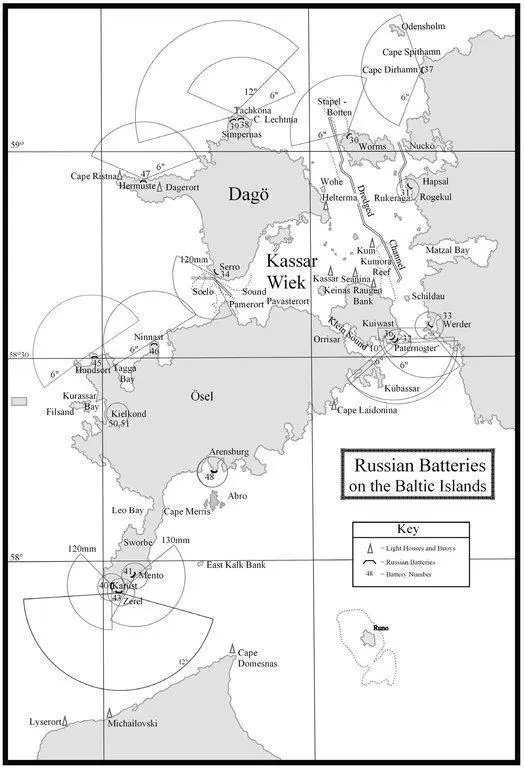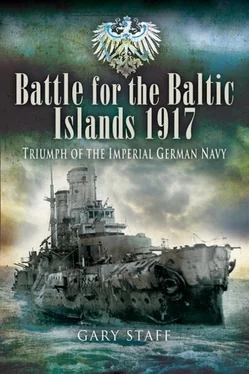
Map 1: Russian Batteries on the Baltic Islands.
The third part of the Russian defence were the naval units, which were known as the Naval Forces of the Riga Gulf, or MSRZ. This force was considerable and consisted of the following:
Commander: Vice Admiral Bakhirev.
Chief of Staff: Captain 2nd Rank Muromtsev.
Flagship: Bayan
Battleships: Slava , Graschdanin
Cruisers: Admiral Makarov , Diana
Gunboats: Chrabry , Grozyashchi , Chivinetz
Destroyers
Commander: Rear Admiral Stark.
Flagship: Novik .
I Division Torpedoboat-Destroyers
II Division Torpedoboat-Destroyers
III Division Torpedoboat-Destroyers
IV Division Torpedoboat-Destroyers
V Division Torpedoboat-Destroyers
VI Division Torpedoboat-Destroyers
Submarines
C26, C27, C32.
Fleet train
Guard Ship Division of the Baltic
VIII Torpedoboat Division
XI Torpedoboat Division
Minelayers: Pripyat , Amur , Wolga
Five Divisions of Minesweepers.
The air stations at Lebara, Kielkond and Arensburg could field around fifty seaplanes and flying boats and ten land-based Nieuport types. The Russian forces were well balanced and their ships had all had combat experience and had proved themselves tough adversaries.
The main base for the Naval Forces of the Riga Gulf was Kuiwast Roadstead, which was convenient and safe, as was the destroyer and submarine base at Rogekul, but they were removed from the Irben Straits. There were auxiliary bases at Arensburg and Piya Bay for the light forces but they were not secure against U-boats. The Moon Sound channel was the main arterial link for reinforcements but even with its dredged depth it was considered impassable for the battleships Andrei Pervozvannyi and Respublika (formerly Imperator Pavel I ).
The leader of the Naval Forces of the Riga Gulf was Vice Admiral Michael Koronatovich Bakhirev, known to his colleagues as ‘Crown’. Rear Admiral K. K. Pilkin wrote of him: ‘He was a clever, simple and kind person. He was trusted, listened to the opinions of those older, more experienced in naval traditions, and was very popular in the Fleet’. Vice Admiral Bakhirev was born on 17 June 1868. He served with distinction in the Russo-Japanese War and was much decorated. He began the First World War as commander of Rurik , the fleet flagship. In December 1914 he was promoted Rear Admiral and was given command of the 1st Cruiser Brigade. He led this unit in the Battle of Ostergarn on 2 July 1915. In December 1915 he was appointed commander of the 1st Battleship Brigade, the dreadnought squadron. He survived the murderous ravages of the revolution and was already a Vice Admiral and Commander of the Mine Defences of the Baltic when in summer 1917 the Commander of the Fleet, Vice Admiral Verderski requested him to familiarize himself with the state of affairs in the Riga Gulf. On 2 August the new Fleet commander, Rear Admiral Razvozov, gave him the following order: ‘In the case of the beginning of an operation by the German fleet in the Riga Gulf, I charge you, honorable Vice Admiral, to take up the overall command of the Naval Forces of the Riga Gulf and Moon Sound Position and to conduct actions as previously discussed’. Vice Admiral Bakhirev was frequently in the Gulf after that and collected the staffs aboard the transport Libau , on Kuiwast Roadstead, which was connected to shore by telephone. M. K. Bakhirev was later murdered by a Bolshevik court on 9 January 1920, after refusing to flee to Finland.
The morale of the Russian crews and garrison was also an imponderable circumstance. During the revolution many officers had been murdered or replaced and new commanders were sometimes elected by the crews. Each ship had an elected committee with which the officers had to consult. In 1919 Vice Admiral Bakhirev wrote a report about the actions of the Naval Forces of the Riga Gulf and he described the situation thus:
The ships committees wished to interfere with everything, not only military matters, and even demanded their presence be allowed to read and analyze operational telegrams…. The cheap politics was easily spread: there were nearly daily gatherings of the ships delegates and eternally messages were passed by semaphore and signal lamp…. The failing discipline of the crews was expressed in many apparent trifles, but these had tremendous value to life aboard the ships. Leave was given freely and there were unaccountable political and economic business trips given freely to essential crew.
Despite this I was still sure of the crews of those ships that had been in the Riga Gulf since the early spring, and sincerely believed they would be able to repulse the enemy and successfully defend the Gulf from being mastered by the enemy.
Nevertheless, a period of bad weather intervened towards the end of September as autumn storms raged and the German operation had to be postponed. The Germans had planned preparatory air attacks but many of these could not be carried out. There were some successes however. As the Russian torpedoboat destroyer Okhotnik carried out picket duty in the manoeuvre basin near buoy number 4 on 26 September, she struck a German mine. This mine had been laid by a German aircraft and Okhotnik carried the dubious distinction of being the first warship sunk by an aerial mine. Neither the commander nor officers wished to abandon ship. Harald Graf described the situation as follows:
Soon all the boats were overflowing with sailors and nobody thought to offer the officers a place. They considered it improper to ask for a place and remained aboard the torpedoboat, silently observing the leaving of the boats. The torpedoboat sank, and soon water flooded over the deck on which the officers stood…. With Okhotnik two more officers were lost, the commander Senior Leitenant V. A. Fok, and Leitenant V. K. Panferov.
At the beginning of October the German air offensive was stepped up and during the nights of 1, 5, 9 and 10 October a total of 5,900 kilograms of bombs were dropped on Zerel, Hainasch and Pernau. During the night of 30 September/1 October a bombing raid was conducted against the 12-inch gun battery at Zerel. The results were devastating. The following is from a copy of the telephone conversation between Captain 1st Rank Knüpfer (formerly commander of the torpedoboat Voiskovoi and now the commander of the Zerel Battery) and Captain 2nd Rank Muromtsev, the one and only Staff Officer of Vice Admiral Bakhirev.
Captain Knüpfer asks Captain Muromtsev to come to the telephone. ‘Captain Muromtsev on the telephone’.
Knüpfer speaks: ‘I request to report to the Admiral on the following. I have ordered Leitenant Stepanov to make inquiries to find the reason for the explosion of the magazine and he has already started and given the following picture: the bomb has fallen before the door of the magazine and a splinter has punched a hole, the powder was ignited and a fire started inside the magazine; cases of powder were thrown out by the explosion and set fire to a shed and a mill.
Captain 2nd Rank Loman, Leitenants Timofeev, Maksutin, Ensign Voskresensky, Sub-Leitenants Polikarpov, Grigorev, Manikhin, Leitenant Bartinev, Ensigns Volsky and Razdenov and most of the crew of Battery No 43 and the other batteries tried in every way possible to extinguish the fire inside the magazine, smothering it with earth and turf and pouring water through the ventilation pipes. A moment after there were no more flames visible, there was an explosion of one shell and after that 44 shells all at once. The forward wall of the magazine was taken out and the roof was wrecked. Logs and splinters rose to a very significant height and, for example, the body of Captain Loman was found two hundred sazhen [426 yards] from the place where he faced the magazine. Besides Loman, Timofeev and Maksutin, whose body has not yet been found, were also killed. Sub-Leitenant Manikhin, Leitenant Bartinev, Sub-Leitenant V B Polikarpov and Ensign Voskresensky are wounded and contused. I have replaced most of the sailors from separate Guards Regiments, but it is extremely desirable to promptly replace the experts and officers.’
Читать дальше













